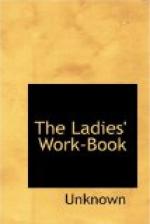We give the section of the handkerchief of the full size, that workers may draw their own pattern from it. It may be made of any dimensions required. The perfect pattern occupies the entire side, reckoning from the open flower at the corner. Were this entirely repeated for the quarter, it would make the handkerchief rather too large for general taste; about one half the pattern, in addition to the piece given (or the open flower, and the two next to it on the inner side) would be found sufficient for the quarter. One-fourth of the handkerchief being drawn on tracing-paper, all the design can be marked from it, on red, blue, or green; but it is preferable to draw a little more than a quarter only, instead of the whole handkerchief, which is cumbersome to hold. When a quarter is done, it may be removed from the paper, which can be used a second time by a careful worker.
No braid whatever is used for this handkerchief, which is similar in the mode of working to some of the most valuable specimens of antique point. The scroll and flowers are close and heavy, the inner ground is guipured, in Raleigh bars, and the space between the scroll and the outer edge is filled with fine and close English lace.
The stem, and the closest part of the flowers (which may be distinguished in the engraving), are done in foundation stitch, with No. 90, point-lace cotton. The veinings of the petals, where they occur in this stitch, are made by taking the foundation thread at double the distance from the last one, and working over it a row of Brussels stitches at the usual distance from each other, instead of close, as in foundation stitch. The calyx of the flower is done in Antwerp lace. The very finest point-lace cotton should be used for all this stitch.
All the flowers, done as we have just described, have a centre worked in Venetian lace; No. 70 cotton must be used.
The open flowers, and the button-hole rounds, are done with Valenciennes thread, No. 120. The English lace, with No. 100 cotton. The Raleigh bars, with Valenciennes, No. 100.
The edge of the handkerchief border is finished with close button-hole stitch, on which Raleigh dots are worked at regular intervals. This edge is worked after all the rest of each quarter is finished.
If it be thought troublesome to outline the whole pattern with thread, No. 5 white cotton French braid may be used. The effect is, however, greatly inferior to that of the thread.
To make up the handkerchief, cut a square of cambric the exact size to fit the lace, allowing for a very narrow hem. When the hem is made, lay the inner line of the lace over it, tack them together, and work a row of close Brussels edge over the two, to connect them.
* * * * *
APRON IN BRODERIE EN LACET.
MATERIALS.—Three-quarters of a yard of wide black silk of satin, two knots of Russia silk braid, of any colour that may be approved, and a dozen skeins of sewing silk to match.




